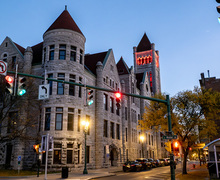That display in Bird Library took months to make
Courtesy of Steven Sartori
Sustainacuse received funding from Campus as a Laboratory for Sustainability, a funding program that stems from SU’s Climate Action Plan.
What seems to be a purposefully-placed pile of plastic bags begins to flash distinctive shades of blue. It moves as though it is breathing.
“That means we got a tweet,” said Neha Navni, a first-year graduate architect student at Syracuse University.
The tweet-activated mechanism is part of Sustainacuse, an interactive installation in E.S. Bird Library, created by a class of 40 architecture and engineering graduate students with the goal of increasing awareness about sustainability.
When someone tweets at the Sustainacuse handle, the mechanism will begin to flash, Navni said. As viewers walk through the installation, floor petals trigger its movement and flowers strung from the ceiling ascend and descend, triggered by motion sensors.
Within the half-circle arch structure are five separate hologram stations, each with a message about sustainability efforts, including information about SU’s Climate Action Plan, plastic in the ocean and the need for nature and technology to coexist.
Katharina Koerber, a first-year graduate student in the architecture program, is part of the team that constructed the flowers, which serve as “moments” within the installation.
Sustainability is growing in importance on the SU campus, Koerber said. Not enough people are aware of what sustainable measures are already in place and what SU has in store for the future, she said.
Michele Pfleuger, a first-year graduate student in the architecture program, worked on the hologram content and structure. Sustainability is a topic that seems untouchable, she said, and the group wanted to bring it to a more tangible level.
“The best part is knowing we have a finished project,” Pfleuger said. “We’re not just working for a grade, it’s real.”
Students began working on the project in February, after they competed to come up with ideas for the installation. Sustainacuse received funding from Campus as a Laboratory for Sustainability, a funding program that stems from SU’s Climate Action Plan. The group was given a budget of $8,460, and was one of six funded by the program.
Monday, their design began to take shape in Bird Library. All week students worked at the library until the early morning hours to ensure the installation was set up properly.
The night before the exhibit opened, they worked until 5 a.m., said Mark Povinelli, an engineering professor who, along with architecture professor Amber Bartosh, served as a faculty mentor for the graduate students.
“Like all art installations, it came together last minute,” he said. Just ten minutes before the installation was set to open, Povinelli was atop a ladder, stringing up a paper flower. “But I’m happy with the way it turned out,” he said, “because the students are happy.”
Collaborations within the university have been done before, Povinelli said, but this is the first time architecture and engineering students have brought their skill sets together to create technology in the form of videos, holograms, interactive elements and virtual reality.
“Collaborations are enriching for the students,” he said.
Adjacent to the installation is a virtual reality headset that allows users to explore different worlds relating to sustainability measures on SU’s campus, including visits to outer space and the ocean.
Drake Gates, an engineering graduate student, helped write the code to make the VR work. He said the collaboration between disciplines was necessary, as the architecture students had knowledge of the 3D modeling tools that the engineering students didn’t.
Gates hopes the installation will get people talking about sustainability in a way that is grounded in reality.
“Maybe they’ll think about recycling and remember our grass world or about solar energy and remember the space world,” he said. “It’ll be a visual reminder.”
Yilu Zhang, a graduate architecture student, said the collaboration was an emulation of what happens in the working world.
“This is how game companies work,” Zhang said. “Architects are in charge of building the models while engineers build the frame.”
Bartosh said another element of the course was the exploration of the role technology and innovation can play in the promotion of sustainability. She said she hopes it will facilitate peer to peer communication about sustainability on SU’s campus.
Carly Saindon, 16, from Newington, Connecticut was on a campus tour when she stumbled upon the installation in Bird.
“It’s intriguing,” she said. “I was just drawn to it.”
Saindon said the exhibit taught her that SU values sustainability and has a plan for its future, which she said is important to her.
“We only have one earth,” Saindon said. “And we need to take care of it like it takes care of us.”
Published on April 15, 2017 at 3:44 pm
Contact Taylor: tnwatson@syr.edu





